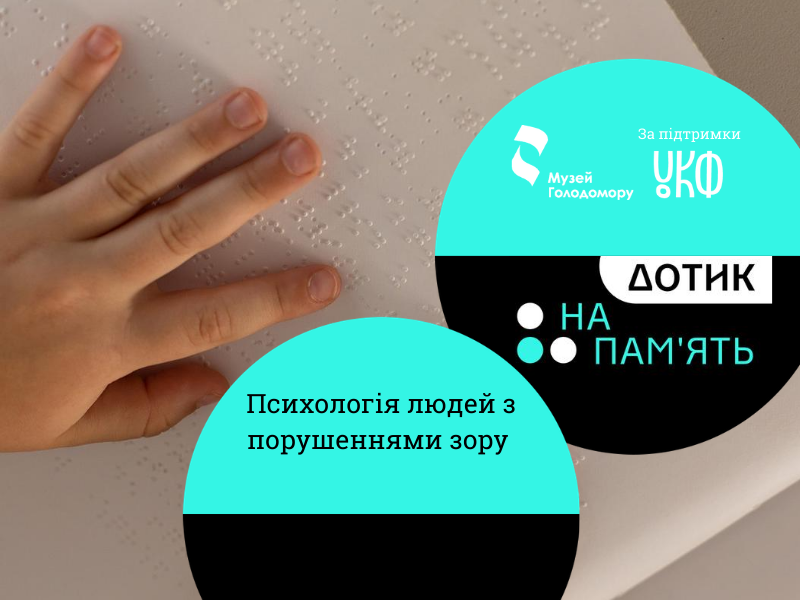Psychology of Visually Impaired People
Within the project “Touch the Memory”, which is implemented with the support of the Ukrainian Cultural Foundation, we publish the abstracts of Olha Sviet’s lecture “Psychology of people with visual impairments.”
Materials provided by Olha Sviet.
Typhlopsychology studies the patterns and features of development of visually impaired people, the formation of processes that compensate for the lack of information, the deficit associated with impaired visual analyzer, and the impact of this disorder on the mental development of visually impaired people.
The main tasks of modern typhlopsychology are:
- study of general and specific patterns of mental development of persons with profound visual impairments, mechanisms that provide compensation for blindness and low vision;
- study of the dependence of mental development on the degree, nature and timing of visual impairment;
- identification of potential opportunities for persons with visual impairment, their ability to overcome deviations while forming mental processes and personal deviations;
- development of psychological bases of effective correctional and pedagogical help to children with defects of visual function;
- creation of a psychological basis for educational and correctional work at different stages of socialization of a person with profound visual impairments;
- development of social and psychological bases of effective integration of persons with visual impairments into society.
The task of corrective and compensatory measures is to influence the whole complex of secondary deviations and the somatic violation that caused them.
Biological compensation is the universal ability of the body to replace the violation or loss of certain functions.
Compensation for blindness and low vision is a biosocial phenomenon, a synthesis of biological and social factors.
Compensation depends on:
- constitutional features of person (their phenotype);
- age of the person;
- their will;
- nature of the impairment;
- secondary disorders;
- social environmental factors.
Pseudocompensation means harmful adaptive formations, which exist as a reaction to undesirable relationships with reality.
How to maintain the attention of people with visual impairments?
- Ask control questions about the information they heard.
- Deliver the material in short semantic blocks.
- The story must be accompanied by tactile objects or models.
- There should be no more than 10 children in the group.
Auditory sensations of persons with visual impairments
One must not hurry during audio description, instead it is necessary to give time for inspection of a tactile element. Describe the provided item from left to right. If necessary, the group can make a circle around the object. You need to provide the maximum number of tactile examples during the tour (fabrics, shapes, forms).
Specific features of excursions for the visually impaired:
- There should be at least 2 guides.
- It is better to book the tours for groups of visually impaired people in the afternoon.
- In the first 5–7 minutes, you should get acquainted with the group and give it time to rest.
- It is useful to give each listener a name badge and then address each visitor by their name.
- Directions to the right / left should be indicated relative to the listeners.
- Visitors must be told immediately where they are.
- During the movement it is necessary to speak, so listeners could be guided by a voice of the guide.
- It is advisable to talk to the teacher / group leader in advance to get detailed information, for example, how many children will attend the museum, etc.
- It is possible to involve extra museum staff who could accompany the visitors if necessary.
- During the tour for blind or partially sighted children, they must be the only group in the hall, so that they will not be not distracted by other visitors.
